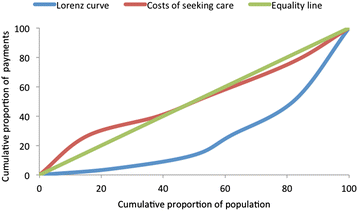Inequity in costs of seeking sexual and reproductive health services in India and Kenya
- PMID: 26374398
- PMCID: PMC4571069
- DOI: 10.1186/s12939-015-0216-5
Inequity in costs of seeking sexual and reproductive health services in India and Kenya
Abstract
Objective: This study aims to assess inequity in expenditure on sexual and reproductive health (SRH) services in India and Kenya. In addition, this analysis aims to measure the extent to which payments are catastrophic and to explore coping mechanisms used to finance health spending.
Methods: Data for this study were collected as a part of the situational analysis for the "Diagonal Interventions to Fast Forward Enhanced Reproductive Health" (DIFFER) project, a multi-country project with fieldwork sites in three African sites; Mombasa (Kenya), Durban (South Africa) and Tete (Mozambique), and Mysore in India. Information on access to SRH services, the direct costs of seeking care and a range of socio-economic variables were obtained through structured exit interviews with female SRH service users in Mysore (India) and Mombasa (Kenya) (n = 250). The costs of seeking care were analysed by household income quintile (as a measure of socio-economic status). The Kakwani index and quintile ratios are used as measures of inequitable spending. Catastrophic spending on SRH services was calculated using the threshold of 10% of total household income.
Results: The results showed that spending on SRH services was highly regressive in both sites, with lower income households spending a higher percentage of their income on seeking care, compared to households with a higher income. Spending on SRH as a percentage of household income ranged from 0.02 to 6.2% and 0.03-7.5% in India and Kenya, respectively. There was a statistically significant difference in the proportion of spending on SRH services across income quintiles in both settings. In India, the poorest households spent two times, and in Kenya ten times, more on seeking care than the least poor households. The most common coping mechanisms in India and Kenya were "receiving [money] from partner or household members" (69%) and "using own savings or regular income" (44%), respectively.
Conclusion: Highly regressive spending on SRH services highlights the heavier burden borne by the poorest when seeking care in resource-constrained settings such as India and Kenya. The large proportion of service users, particularly in India, relying on money received from family members to finance care seeking suggests that access would be more difficult for those with weak social ties, small social networks or weak bargaining positions within the family - although this requires further study.
Figures
References
-
- van Doorslaer E, O’Donnell O, Rannan-Eliya RP, Somanathan A, Adhikari SR, Garg CC, Harbianto D, Herrin AN, Huq MN, Ibragimova S, et al. Effect of payments for health care on poverty estimates in 11 countries in Asia: an analysis of household survey data. Lancet. 2006;368:1357–1364. doi: 10.1016/S0140-6736(06)69560-3. - DOI - PubMed
Publication types
MeSH terms
LinkOut - more resources
Full Text Sources
Other Literature Sources



